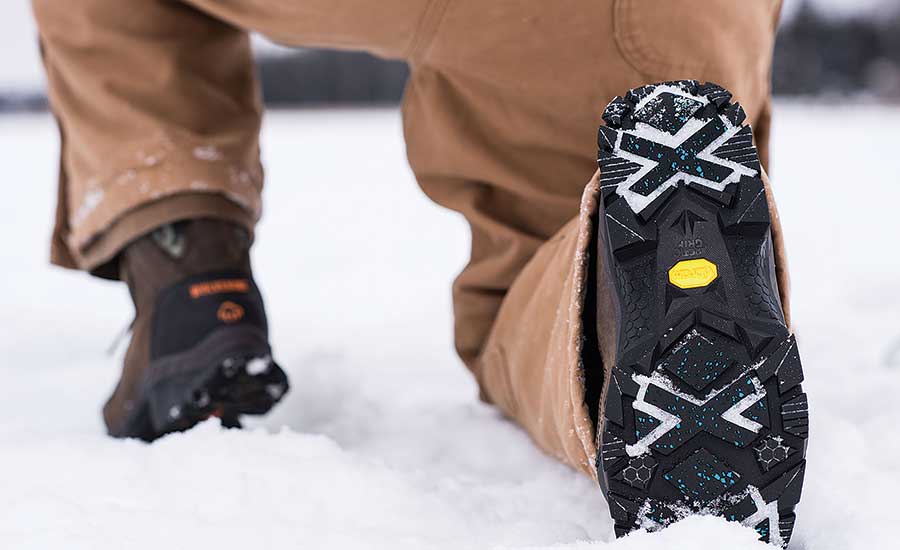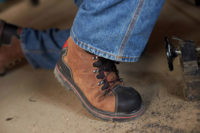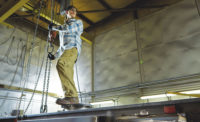Foot protection is a general term that covers countless different features of occupation footwear; there’s no one thing that ensures foot protection, but having a boot with the right combination of features and technologies that work together provides the best comfort and protection.
Like there are different kinds of work in industrial categories, there are many different kinds of occupational footwear designed for specific jobs. The standard features of protective footwear are the ones most often required by employers or are considered prudent to have in certain work environments.
Generally these types of protection are accompanied by The American Society for Testing of Materials (ASTM) rating that signifies that the footwear meets or exceeds specific measures when tested under controlled laboratory conditions.
Covered by ASTM ratings
- Safety-Toe: All safety-toe footwear must meet or exceed the specific ASTM measures for impact and compression. The caps themselves can vary in terms of material composition, the most popular type being the traditional steel cap. However both aluminum alloy and composite (plastic resin) caps are used because they are less heavy while composite caps have the added benefit of not conducting heat or cold thus enhancing internal foot comfort. Recent developments in nanotechnology that features carbon fiber has made it possible to make composite caps that are even lighter and more comfortable.
- Met guard: Footwear that has a met guard built onto (external) or into (internal) them are rated by ASTM to help protect the top and particularly metatarsal areas of the foot from the drop hazards. Typical occupations that tend to employ met guard footwear are foundry workers, pipe fitters, and even some types of warehouse jobs. External met guards are the traditional and original form of this kind of protection and tend to be bulky. However, with the more advanced types of polymers, met guards that were ASTM-rated could be built inside the footwear giving the wearer a less bulky and more flexible, comfortable fit.
- Electrical: Many occupational types of footwear come with an electrical rating. The majority of these are rated EH for electrical hazard. This type of footwear is designed to reduce the danger due to accidental contact with live electrical current (in effect the footwear inhibits grounding of the electrical current).
More specialized than EH footwear is the SD rating, which seeks to reduce the accumulation of static electricity by conducting the electrical charge to the ground in a regulated manner while still protecting the wearer of electrical hazards. This type of footwear is typical used in occupations where the discharge of static buildup can cause problems to machinery (assembly line robotics) or individuals (paint booth operators). - Puncture Resistance: Finally there are types of protective footwear that are ASTM-rated for PR – puncture resistance. The goal here is to reduce the danger of any puncture wounds to the bottom of foot such as stepping on an exposed nailed. Footwear of this type generally has a protective steel plate or a layered aramid fabric insole.
Other types
Not all occupational footwear that is protective involves formal ASTM ratings and testing procedures. Three of the most important of these are waterproof, insulated and slip-resistant footwear.
- Waterproof: The ability to build effective non-rubber waterproof footwear is a relative new development. The central breakthrough in this area came with the invention of reliable waterproof membranes that can be built into the footwear. These days, there are a variety of reliable waterproof membranes in the market. It is important to note that waterproof protection is not regulated in the US by any agreed-upon standards.
- Insulation: Boots that provide insulation against cold environments provide both protection and comfort. Footwear is often insulated with a branded material like Thinsulate or Primaloft or with a generic or proprietary material. Insulated boots come in a variety of insulation levels; lighter levels are more appropriate for occupations where there is regular and constant activity. Higher levels are recommended if the wearer will be less active and more stationary. A composite cap is recommended in insulated boots because it does not conduct cold as steel does.
- Slip Resistance: There is a greater and greater interest within the occupational safety field in protecting individuals from slipping in the workplace. These concerns have the most application to environments that have smooth walking surfaces especially ones that are or can become wet. Protective footwear that is labelled SR is usually built to enhance traction and reduce slippage on smooth and or slick surfaces. Much like waterproof designations, there is no formal standard nor is there an agreed-upon test method in the US that defines SR. However informally speaking, the litmus test of an SR sole in the US has been a .4 result on a Mark II testing for oily-wet surfaces. Most manufacturers of SR footwear either list or provide slip-resistance test results.
Overall performance
In addition to these basic types of footwear protection, there are other components that are relevant to overall performance of a work boot: comfort and durability.
Comfort, although not related directly to safety or protection, is of utmost importance for any job. It needs to be noted that with advances in modern materials and shoemaking, it’s not necessary to trade comfort for protection. For example, carbon fiber safety toes are lighter, non-conductive and thinner for a better fit while still meeting ASTM standards.
Knowing the right protection for your needs coupled with considerations about comfort, durability and quality create the best conditions for an informed choice.





